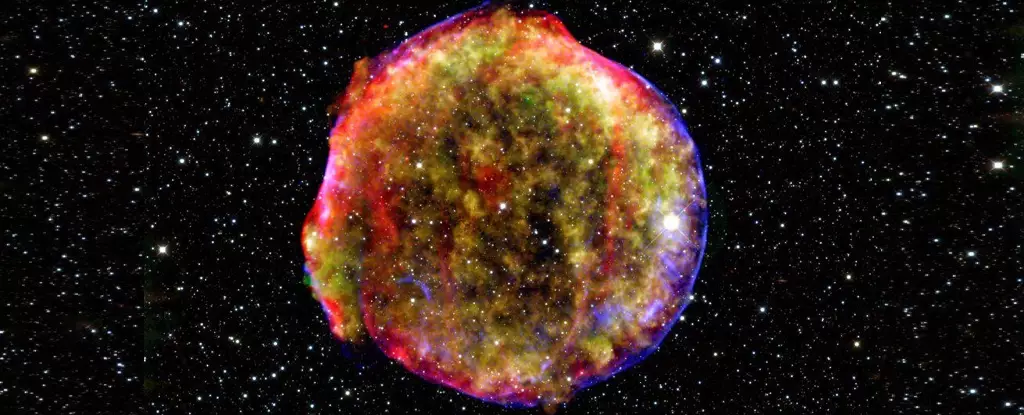In the vast expanse of our universe, hints of supreme power lie cloaked in mystery. The persistent showers of cosmic rays that pelt our planet are an enigma, at once fascinating and perplexing. These particles, traveling at nearly the speed of light, possess energies that dwarf even the most sophisticated human endeavors. For decades, scientists have combed through the cosmos, contemplating the origins of these immensely powerful atomic fragments. Galactic phenomena, particularly the dramatic demises of stars, have been touted as potential accelerators. Yet, there remains a nagging doubt in the scientific community: Can supernovae genuinely be the cosmic engines responsible for these high-energy bombardments? New research sheds fresh light on this question, igniting renewed excitement and skepticism alike.
Supernova—The Cataclysmic Spectacle
Among the most intriguing candidates for high-energy cosmic ray producers are the supernovae—the explosive deaths of stars. Many regard these stellar events as epic displays of nature’s fury, offering a spectacle that captivates both astronomers and astrophysicists. The historical case of Tycho’s star, which captured the attention of stargazers in 1572, serves as a timeless reminder of the astronomical wonders that once lit up our sky. At its core, Tycho’s star was a white dwarf, collapsing under the weight of its dying power. The explosion not only marked the end of a stellar life cycle but also possibly offered an ephemeral opportunity for cosmic ray acceleration in its immediate aftermath. As scientists sift through numerical simulations, they are faced with the monumental task of discerning fact from fiction.
Unearthing a Cosmic Mystery
Recent insights by an international team of researchers suggest that dying stars might still have a role to play in the cosmic ray story. Their analysis of the magnetic fields produced during supernova events raises compelling questions about how effectively these remnants can accelerate particles. Although their findings indicate that the capacity to generate cosmic rays may be “significantly smaller” than predicted, they stop short of dismissing supernovae as a source altogether. This creates an ambiguous stance, stirring both hope and doubt among scientific circles. Are we on the brink of uncovering a previously misunderstood aspect of stellar death, or are we merely chasing after shadows in the cosmic dust?
PeVatrons: The Forbidden Fruit of Astrophysics
Enter the concept of PeVatrons—hypothetical cosmic engines theorized to produce particles with peta-electronvolt (PeV) energies. These particles soar through the universe—remarkably powerful and strikingly rare. The prospect of finding a mechanism that generates such cosmic bullets is tantalizing. Current models suggest that supernovae could be the elusive PeVatrons, linking the grandeur of stellar explosions with the chaotic dance of fundamental particles. Yet, the catch lies in understanding the timing: supernova remnants need to reach a critical density to create the conditions necessary for this form of acceleration. It is a cosmic race against time; if the stellar shell dissipates too quickly, the opportunity vanishes like smoke.
The Richness of Scientific Inquiry
What resonates profoundly is the idea that science is often more about asking the right questions than finding definitive answers. The ongoing inquiry into cosmic rays and their origins highlights the ever-evolving nature of astrophysics, where certainty is a rare commodity. As researchers wrestle with these cosmic challenges, they may be edging closer to a turning point in our understanding of the universe. The interplay between theoretical physics and observational evidence points to a captivating reality: our comprehension of high-energy particles remains unfinished, always pushing us to rethink our ideas while remaining grounded in empirical investigation.
The Unwritten Future of Cosmic Exploration
Even after centuries of observations and theories, the cosmos continues to dazzle and baffle us. The discoveries related to Tycho’s star and the potential role of dying stars in particle acceleration offer glimpses of a broader tapestry yet to be fully unraveled. As we await the next supernova event, there lies a unique path forward—one characterized not by desperation, but by curiosity. This is a chance for humanity to embrace the uncertainties and complexities of the universe, paving the way for groundbreaking revelations that may forever alter our understanding of nature’s most profound phenomena. This fascinating interplay between exploration and discovery forms the very essence of scientific progression. Our thirst for knowledge, even amidst ambiguity, propels us into the infinite darkness of space—ever hopeful for the light of revelation.


Leave a Reply